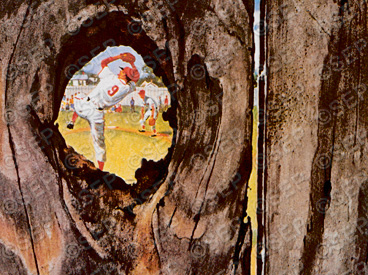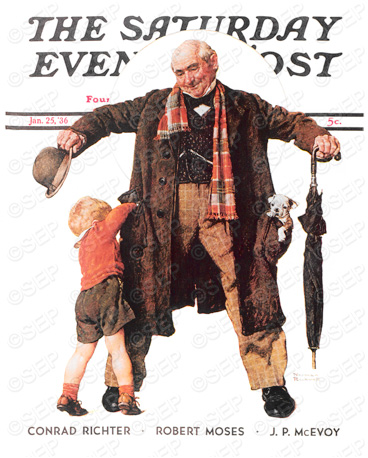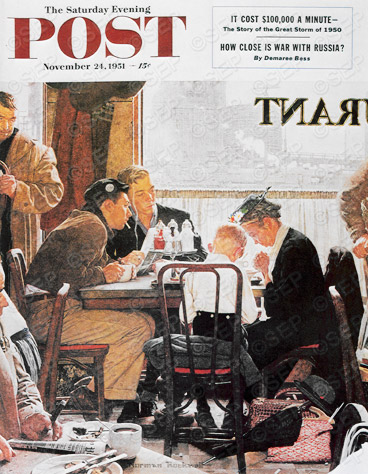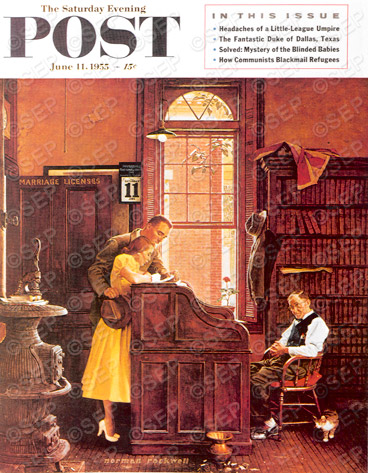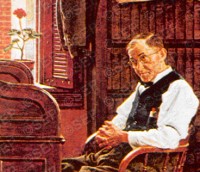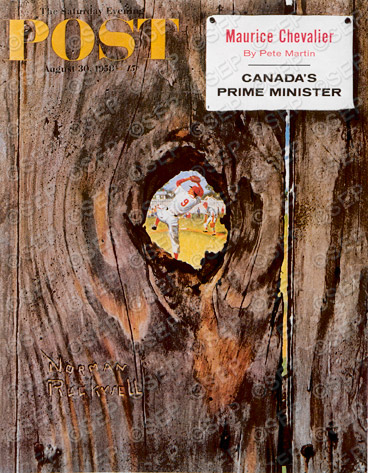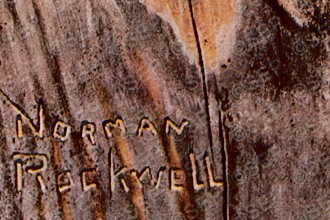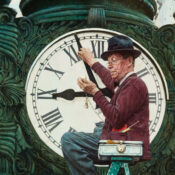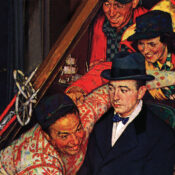We want to hear about your favorite covers from The Saturday Evening Post, whether illustrated by Norman Rockwell or another Post artist. This week we’re reviewing Rockwell favorites from readers and our own staff.
The Gift
Norman Rockwell
January 25, 1936
Helen Palmquist of Lincolnshire, Illinois, went right for a fun one: “My favorite is the little boy looking in Grandpa’s overcoat, not realizing a puppy is in the other pocket.” Rockwell had his beloved Uncle Gil in mind when he created this 1936 cover. Uncle Gil was something of a scientist and inventor, Rockwell wrote in My Life as an Illustrator. “But he did have one eccentricity, he got his holidays mixed up. On Christmas day, with snow on the ground and a cold wind in the trees, Uncle Gil would arrive loaded with firecrackers to celebrate the Fourth of July. On Easter he would bring us Christmas gifts.
“He always had a kind of Christmas spirit about him—jovial, warmhearted, shouting, ‘Warm, Norman, warm!’ as I approached a hidden present and ‘Hurrah!’ when I found it. … I don’t think I have ever enjoyed any gifts as much as I used to Uncle Gil’s.”
Saying Grace
Norman Rockwell
November 24, 1951
Saying Grace is the favorite of Nicole Beer from our staff in Indianapolis, Indiana. “It reminds me of my grandmother even down to the way Rockwell painted the lady’s hands. I remember being a kid and always praying in public with her before we ate. Everyone would always stare at us and it would make me embarrassed. I hated it as a kid but as an adult, I am so thankful for her and the example she set. I can only hope I am as bold with my faith as she was.”
Saying Grace has an interesting history. Click here to read about which of Rockwell’s sons appears in this illustration and how fellow Post artist George Hughes’ discouragement drove Rockwell to complete this painting.
The Marriage License
Norman Rockwell
June 11, 1955
“There is only one that stands head and shoulders above the rest in terms of sheer beauty and deep meaning—The Marriage License,” writes Barbie Thompson of Calgary, Alberta.
“Manning this department, no doubt years before these two lovebirds were even born,” writes Barbie of the elderly clerk, “[he] has seen it all and therefore knows this path all too well—the Good and the Bad, the Happy and Not-So-Happy Endings. The only personal warmth for him now comes from his kitty, those well-smoked cigarettes, and the well-chewed loose tobacco targeted to the spittoon, and the slow-burning, unseen embers from that ancient cast-iron stove.”
Barbie may be more right in that last sentence than she knows. Anne Braman, daughter-in-law of the gentleman who posed as the clerk, wrote in a 1976 Post article that her mother-in law had died the year The Marriage License was painted.
Close-up of elderly clerk.
“Mr. Rockwell—knowing my father-in-law Jason C. Braman—realized how upset he was, and he thought if he could get him to model it would give him something new to think about.”
Rockwell was right about the new activity having a therapeutic effect on the widower, wrote Anne, “As soon as the The Marriage License appeared on the cover of the Post, people recognized him immediately. When his friends commented to him about the cover, he would say, ‘Would you like for me to autograph your copy?’ And he would. When I told Mr. Rockwell about this, he was quite amused.”
[Anne Braman modeled for Rockwell as the schoolteacher in the 1956 cover Happy Birthday Mrs. Jones. Read more about her here.]
Knothole Baseball
Norman Rockwell
August 30, 2958
“I love all baseball covers, but I find this one particularly interesting,” writes Cris Piquinela one of our Post staffers.
“First off, I don’t think most people looking at this cover would think it is a Rockwell. There are no children or people visible, no characteristic facial expressions. However, what I like about this cover is that it forces me to ‘create’ or imagine the scene in my head. I can’t see the person looking through the hole, but I imagine a freckled, redheaded, barefoot kid. At the same time, I can sense the excitement of the pitch, a great hit by the player at bat, and the entire crowd going crazy. This cover does not tell me what I am looking at … it forces me to imagine it. Plus, I love only having a small piece of the image shown to me.”
Rockwell’s carved signature.
It is also interesting to note the way Rockwell “carved” his signature in the painting.
A special thank you to readers (and Post staff) for telling us about your favorite Rockwell covers!
Visit our online gallery to review Post covers by your favorite artist.
Coming soon in our Readers’ Favorites series: readers’ favorite covers from Rockwell’s neighbor, friend, and fellow Post artist George Hughes. If you have a favorite George Hughes cover (and there are 115 to choose from) we’ll be glad to feature it.
View covers by George Hughes here, then email us your name, along with the title and date or just a good description of your favorite piece at [email protected].
Become a Saturday Evening Post member and enjoy unlimited access. Subscribe now
